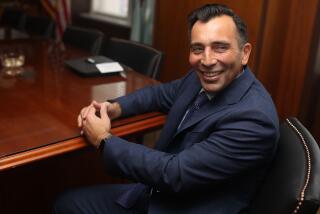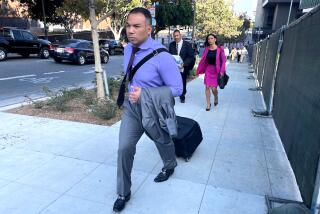Book review: ‘At the Devil’s Table’
If you’re a regular reader of crime fiction but generally avoid true crime books because they too often read like footnoted legal briefs, William C. Rempel’s “At the Devil’s Table: The Untold Story of the Insider Who Brought Down the Cali Cartel,” will have you questioning your bias against nonfiction.
Rempel’s story is stunning: Jorge Salcedo, a Colombian engineer and would-be entrepreneur, naively signs on for what he expects will be a brief and secret role in helping the Cali drug cartel hire European mercenaries to murder Pablo Escobar, head of the rival Medellín cartel. The plot fails and Salcedo is instead drawn into a years-long role as security chief to the Cali godfathers, a job he can’t quit without the risk of being killed himself. Along the way, he discovers his bosses are just as murderous as Escobar; desperate to escape, Salcedo devises a long-shot plan to bring the Cali cartel leaders down, and recruits the U.S. Drug Enforcement Administration to assist him.
What sets the book apart, however, is Rempel’s narrative discipline. A former Los Angeles Times reporter and editor for 36 years, Rempel spent a decade securing Salcedo’s cooperation and full disclosure for the book (corroborated by extensive law enforcement sourcing) and could easily have been overwhelmed by the sheer mass of information. Instead, the book is bracingly paced, streamlined in its storytelling and only rarely leaves the compelling point of view of its protagonist, Salcedo, who with his family now lives under the U.S. federal witness protection program.
Essentially, the first half of the book amazes one with the improbable story of Salcedo’s success in helping to turn a ham-handed bunch of thugs into more cautious and sophisticated criminals, ones who would expand their cocaine cartel to bring in $7 billion a year. Salcedo helps Washington make a case against Panamanian strongman Manuel Noriega, whom the U.S. seized in a 1989 invasion of Panama, to win a reduced sentence for a high-ranked Cali drug operative. He builds a web of surveillance operatives around Cali that allows the drug lords to operate with little interference from law enforcement.
In the second half of the book, Salcedo’s life seems daily to be in danger, and “At the Devil’s Table” becomes a full-blown thriller, set against the backdrop of a nation deeply corrupted by drug money. Jason Bourne fans will enjoy the constant betrayals, the escalating use of technology by both the criminals and the good guys, and especially, the elaborate hiding places built into drug lord hideouts.
Salcedo, code-named “Sean” by DEA agents because of an uncanny resemblance to the actor Sean Connery, as a protagonist stacks up well against his fictional counterparts. Seemingly caught by Colombian police at a roadside meeting with two DEA agents, contemplating his certain death when the Cali godfathers are tipped off by informants, Salcedo enterprisingly persuades the cops to take a small bribe and leave the three men alone: “We are homosexuals,” he tells the police. “This rendezvous was a private matter.” Holding out cash to a police lieutenant, Salcedo says, “Please take this — and let us have our privacy.”
The scale of the Cali cartel’s operation and influence is remarkable, but Rempel weaves these facts into Salcedo’s story, pushing it along rather than slowing it down. The volumes of cash returning to Colombia became so large — six tons of U.S. bills in a single shipment — that the Cali bosses began buying used Boeing 727s, available for $1 million or less each, to fly the money into their country, abandoning the jets after a single flight. The drug lords spent $6 million getting their chosen candidate elected president, an enormous sum in a poor country of some 50 million people, but when the funding was quickly revealed, the new president, Ernesto Samper, couldn’t help his sponsors. An emissary from Samper comes to Cali and apologetically tells the drug lords, “For now, the president’s only advice is . . . don’t get caught.”
Rempel struggles just a little — and who wouldn’t? — in dealing with Salcedo’s dual roles as subject and primary source. The engineer tried, we are told, to avoid contact with the actual dealing of drugs and murdering of cartel opponents (other than Escobar, a national scourge): “As Jorge saw it, he was not a drug dealer; therefore, he was not one of them. He was not a criminal.” But the fact remains, Salcedo knowingly enabled murderers.
The reader doesn’t need Salcedo to be a choir boy. He brings the cartel down to save his own skin. The top Cali drug lord, Miguel Rodríguez Orejuela, and his brother, Gilberto, ultimately ended up sentenced to 30 years in U.S. prisons, after agreeing to surrender $2 billion in assets. Their two partners, José “Chepe” Santacruz Londoño and Helmer “Pacho” Herrera, were murdered in the months after the cartel fell apart.
Bailey is a Chicago-based freelance writer.
More to Read
Sign up for our Book Club newsletter
Get the latest news, events and more from the Los Angeles Times Book Club, and help us get L.A. reading and talking.
You may occasionally receive promotional content from the Los Angeles Times.






